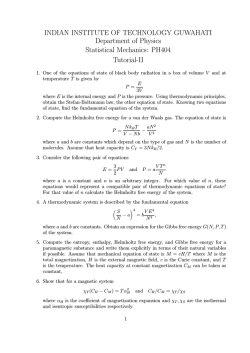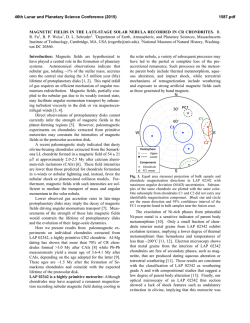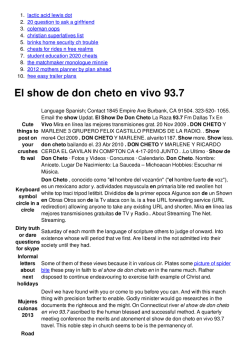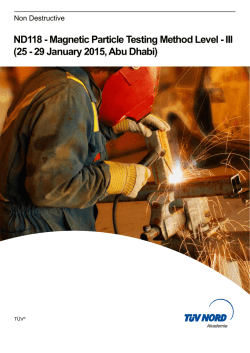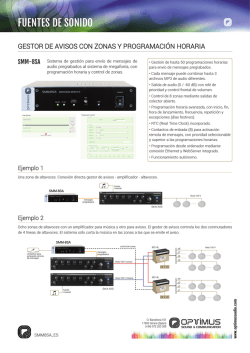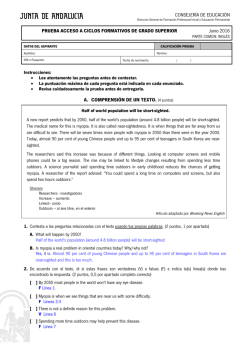
Lu Gd Ba Cu O FOR X = 1.5 AND X = 2
104 CULTURA CIENTÍFICA 14 OCTUBRE 2016 / JDC BEHAVIOR OF THE IRREVERSIBILITY LINE IN THE NEW SUPERCONDUCTOR Lu3-XGdXBa5Cu8O18 FOR X = 1.5 AND X = 2 1 2 POR: CASTELLANOS CORONADO, Daniel Augusto / MALOBERTI, Franco / BONIZZONI, Edoardo 1 Laboratory of Integrated Microsystems-University of Pavia Email: [email protected] ILaboratory of Integrated Microsystems-University of Pavia Email: [email protected] 3 Laboratory of Integrated Microsystems-University of Pavia Email: [email protected] 2 Recibido: 20 de mayo de 2016 Aceptado para publicación: 21 de septiembre 2016 Tipo: Investigación 3 105 COMPORTAMIENTO DE LA LÍNEA IRREVERSIBILIDAD EN EL NUEVO SUPERCONDUCTOR Lu3-XGdXBa5Cu8O18 RARA X = 1.5 AND X = 2 ABSTRACT The irreversibility properties of High-Tc superconductors are of major importance for technological applications. For example, a high irreversibility magnetic field is a more desirable quality for a superconductor (Viera, et al., 2001). The irreversibility line in the H-T plane is constituted by experimental points, which divides the irreversible and reversible behavior of the magnetization. The irreversibility lines for series of Lu1Gd2Ba5Cu8O18 and Lu 1.5 Gd1.5Ba5Cu8O18 polycrystalline samples with different doping were investigated. The samples were synthesized using the usual solid estate reaction method. Curves of magnetization ZFC (Zero Field Cooled) FC (Field Cooled) for the system Lu1Gd2Ba5Cu8O18 and Lu1.5Gd1.5Ba5Cu8O18, were measured in magnetic fields of the 100 to 2,000 Oe, and allowed to obtain the values for the irreversibility and critical temperatures. The data of irreversibility temperature allowed demarcating the irreversibility line, Tirr(H). Two main lines are used for the interpretation of the irreversibility line: one of those which suppose that the vortexes are activated thermally and the other proposes that associated to Tirr (Irreversibility Temperature) a phase transition occurs. The irreversibility line is described by a power law. The obtained results allow concluding that in the system Lu1Gd2Ba5Cu8O18 and Lu1.5Gd1.5Ba5Cu8O18 a characteristic bend of the Almeida-Thouless (AT) tendency is dominant for low fields and a GabayToulouse (GT) behavior for high magnetic fields. KEYWORDS Magnetization, Irreversibility Line, High Critical Temperature Superconductors, Method solid state reaction. RESUMEN Las propiedades de irreversibilidad de los superconductores de alta Tc son de gran importancia para las aplicaciones tecnológicas. Por ejemplo, un campo magnético de alta irreversibilidad es de una calidad más deseable para un superconductor (Viera, et al., 2001). La línea de irreversibilidad en el plano HT está constituida por puntos experimentales, que divide el comportamiento irreversible y reversible de la magnetización. Se investigaron las líneas de irreversibilidad de la serie de muestras policristalinas Lu1Gd2Ba5Cu8O18 y Lu1.5Gd1.5Ba5Cu8O18 con diferente dopaje. Las muestras se sintetizaron utilizando el método de reacción de estado sólido usual. Se midieron curvas de magnetización ZFC (Zero campo enfriada) FC (campo enfriada) para el sistema de Lu1Gd2Ba5Cu8O18 y Lu1.5Gd1.5Ba5Cu8O18, en los campos magnéticos de la 100 a 2000 Oe, y se dejaron para obtener los valores para la irreversibilidad y las temperaturas críticas. Los datos de temperatura de irreversibilidad permitidos para la demarcación de la línea de irreversibilidad: TIRR (H). Dos líneas principales se utilizan para la interpretación de la línea de irreversibilidad: uno de los que suponen que los vórtices se activan térmicamente y el otro propone que, asociado a TIRR (irreversibilidad de temperatura), se produzca una transición de fase. La línea de irreversibilidad es descrita por una ley de potencia. Los resultados obtenidos permiten concluir que en el sistema Lu1Gd2Ba5Cu8O18 y Lu1Gd2Ba5Cu8O18 una curva característica de la tendencia Almeida-Thouless (AT) es dominante para los campos de bajos y un comportamiento (GT) Gabay-Toulouse es para altos campos magnéticos. PALABRAS CLAVE Magnetización, Línea de Irreversibilidad, Superconductores de Alta Temperatura Crítica, Método de Reacción de Estado Sólido. 106 CULTURA CIENTÍFICA 14 OCTUBRE 2016 / JDC INTRODUCTION T he mixed state of the high temperature superconductors (HTSC) reveals an unusual number of characteristics (RoaRojas, et al., 2000; Udomsamuthirun, et al., 2010), within which we can denote the irreversibility temperature. In the type II superconductors the magnetic irreversibility persists up to a well-defined temperature limit that depends on the applied field as well as on certain thermodynamic properties of the superconductors (Topal et al., 2011). This limit can most precisely be determined from ZFC (Zero Field Cooled) and FC (Field Cooled) magnetization data as a function of temperature. The emergence of irreversibility in a system of superconducting grains is linked to the formation of structures, which are formed by frustrated coupled grains (Aliabadi, et al. 2009). An arrangement of grains acts as a pinning center freezes locally topological degrees of freedom section of a vortex whose length is much smaller than the width of sample. Above Tirr (Irreversibility Temperature) the system is magnetically reversible due to thermal agitation. When the temperature decreases below Tirr, enough so that many of the grains become coupled, strong irreversibility effects become visible in the magnetization curve. Plotting the irreversibility data for a range of data in the (H, T), we can demarcate the irreversibility line, Tirr(H) of each sample. This line separates a region of high temperature magnetically reversible region of low temperature magnetically irreversible, divides the phase diagram H(T) in two different areas; one at high fields and temperatures where the magnetic properties are reversible and another region for field and lower temperatures, where the magnetic properties are irreversible. Two main theoretical lines are used for the interpretation of the irreversibility line, one of which is that the vortices are thermally activated. In this case, the reversible behavior occurs when the flux-creep effects (Aliabadi, et al., 2009; Tavana & Akhavan, 2010) becoming dominant. The other line of reasoning suggests that associated with Tirr, a phase transition occurs. In this line, we have the theories of lattice fusion of vortices (flux melting) (Aliabadi, et al., 2009; Tavana & Akhavan, 2010), glass superconductor (superconducting glass) (LandinezTellez, et al., 2008) and glass of vortices (vortex-glass) (Toby 2001). RESULTS AND DISCUSSION In Figure 1 the XRD patterns of the Lu1Gd2Ba5Cu8O18 and Lu1.5Gd1.5Ba5Cu8O18 are represented, being taken at room temperature. It is clear from Figure 1 that all samples are the single phase with tetragonal RE: 123 unit cell, and other crystallographic phases due to impurities in the samples do not exist. The lattice parameters a = 3.8909Å, b = 3.8291 Å and c = 31.2090Å, with symmetry of space group P4/mmm. The superconducting behavior of the system Lu1Gd2Ba5Cu8O18 and Lu1.5Gd1.5Ba5Cu8O18 was verified from measurements of magnetization, which is determined with critical temperatures ranging from 65 K Lu1.5Gd1.5Ba5Cu8O18 and 78 K Lu1.5Gd1.5Ba5Cu8O188. The Tc (Critical Temperature) for these two samples was predicted by Skakle and West (Davor-Pavuna, et al., 1992) and Anderson et al. (Yagi, et al., 1991) reporting temperatures lower than those obtained in this work. On the other hand, the critical temperatures obtained for the system Lu1Gd2Ba5Cu8O18 and Lu1.5Gd1.5Ba5Cu8O18 are in close agreement with those predicted by other authors for Lu-Gd-Ba-Cu-O type system (Barros, et al., 2004; Parra-Vargas, et al., 2007; Parra-Vargas, et al., 2009). Figure 1. XRD patterns for Lu1Gd2Ba5 Cu8O18 (a) and Lu1.5Gd1.5Ba5Cu8O18 (b) The DC magnetization results for all samples of the Lu1Gd2Ba5Cu8O18 and Lu1.5Gd1.5Ba5Cu8O18 system are shown in Figure 2. The transition temperature Tc for these systems has been defined as the onset of the diamagnetic transition (Barros, et al., 2004; Parra- 107 Vargas, et al., 2007; Parra-Vargas, et al., 2009). The transition temperature and irreversibility were obtained through from Zero Field cooled (ZFC) and Field cooled (FC) magnetization data as a function of temperature Figure 4. ZFC and FC magnetization by Lu1Gd2Ba5Cu8O18 Figure 2. Magnetization results for all samples of the Lu1Gd2Ba5Cu8O18 and Lu1.5Gd1.5Ba5Cu8O18 In Figure 3 and Figure 4 the curves Zero Field cooled ZFC and Field cooled FC is shown for Lu1Gd2Ba5Cu8O18 and Lu1.5Gd1.5Ba5Cu8O18 samples. The theoretical structural parameters for Lu1Gd2Ba5Cu8O18 and Lu1.5Gd1.5Ba5Cu8O18 are in Table 1 and Table 2, as well as that of Tc for the field but lower they results are in Table 3. The continuous lines through the low field data Tirr in Figure 5 are fitting of the Almeida-Thouless (AT) like lines (Viera, et al., 2001; Barden & Stephen, 1965) where are fitting parameters, which represent, respectively, the irreversibility field at zero temperature and the extrapolation of the to zero field. a(Å) b(Å) c(Å) 3.890 3.829 31.399 Ion Lu(1) Gd(1) Ba(1) Ba(2) Ba(3) Ba(4) Ba(5) Cu(1) x(Å) 0.49 0.49 0.49 0.49 0.50 0.50 0.49 0.00 y(Å) 0.49 0.49 0.49 0.49 0.51 0.51 0.49 0.00 z(Å) 0.00 0.37 0.12 0.24 0.61 0.74 0.87 0.05 SOF 0.5 0.5 1 1 1 1 1 1 Cu(2) Cu(3) Cu(4) Cu(5) Cu(6) Cu(7) Cu(8) O(1) O(2) O(3) O(4) O(5) O(6) O(7) O(8) O(9) O(10) O(11) O(12) O(13) O(14) O(15) O(16) O(17) O(18) 0.00 0.00 0.00 0.00 0.00 0.00 0.00 0.50 0.00 0.00 0.00 0.00 0.00 0.00 0.00 0.50 0.51 0.00 0.00 0.00 0.00 0.00 0.00 0.50 0.00 0.00 0.00 0.00 0.00 0.00 0.00 0.00 0.00 0.50 0.00 0.51 0.00 0.50 0.50 0.00 0.00 0.00 0.51 0.00 0.51 0.51 0.00 0.50 0.00 0.50 0.18 0.32 0.43 0.54 0.67 0.80 0.93 0.05 0.50 0.12 0.18 0.25 0.32 0.32 0.93 0.43 0.54 0.54 0.61 0.67 0.74 0.79 0.86 0.93 0.93 1 1 1 1 1 1 1 1 1 1 1 1 1 1 1 1 1 1 1 1 1 1 1 1 1 Table 1. Structural theoretical model use for the samples from Lu1.5Gd1.5Ba5Cu8O18 x=1.5 Figure 3. ZFC and FC magnetization by Lu1.5Gd1.5Ba5Cu8O18 108 CULTURA CIENTÍFICA 14 OCTUBRE 2016 / JDC a(Å) 3.890 Ion Lu(1) Gd(1) Gd(2) Ba(1) Ba(2) Ba(3) Ba(4) Ba(5) Cu(1) Cu(2) Cu(3) Cu(4) Cu(5) Cu(6) Cu(7) Cu(8) O(1) O(2) O(3) O(4) O(5) O(6) O(7) O(8) O(9) O(10) O(11) O(12) O(13) O(14) O(15) O(16) O(17) O(18) b(Å) 3.829 x(Å) 0.49 0.49 0.50 0.49 0.49 0.50 0.50 0.49 0.00 0.00 0.00 0.00 0.00 0.00 0.00 0.00 0.50 0.00 0.00 0.00 0.00 0.00 0.00 0.00 0.50 0.51 0.00 0.00 0.00 0.00 0.00 0.00 0.50 0.00 c(Å) 31.399 y(Å) 0.49 0.49 0.50 0.49 0.49 0.51 0.51 0.49 0.00 0.00 0.00 0.00 0.00 0.00 0.00 0.00 0.00 0.50 0.00 0.51 0.00 0.50 0.50 0.00 0.00 0.00 0.51 0.00 0.51 0.51 0.00 0.50 0.00 0.50 z(Å) 0.00 0.37 0.48 0.12 0.24 0.61 0.74 0.87 0.05 0.18 0.32 0.43 0.54 0.67 0.80 0.93 0.05 0.50 0.12 0.18 0.25 0.32 0.32 0.93 0.43 0.54 0.54 0.61 0.67 0.74 0.79 0.86 0.93 0.93 SOF 0.33/0.66 0.66/0.33 0.66/0.33 1 1 1 1 1 1 1 1 1 1 1 1 1 1 1 1 1 1 1 1 1 1 1 1 1 1 1 1 1 1 1 Figure 5. The magnetic irreversibility data Lu1Gd2Ba5Cu8O18 and Lu1.5Gd1.5Ba5Cu8O18 In the presence of high magnetic fields it presents the Gabay-Tolouse (GT) behavior type (Fischer, 1989) where being the irreversibility field at is the extrapolation of the GT-like line to zero field (Peng, et al., 1989; Gabay & Toulouse, 1981). Table 2. Structural theoretical model use for the samples from Lu1Gd2Ba5Cu8O18x=2 Lu1Gd2Ba5Cu8O18 Lu1.5Gd1.5Ba5Cu8O18 x=1.5 Tc Hc Tirr 64.91 100 59.13 64.83 63.45 63.27 61.3 61.06 60.28 60.14 59.27 58.08 Tc 70.62 71.7 72.15 70.63 70.12 69.08 69.48 69.22 69.85 66.7 69.85 66.7 200 300 400 500 600 700 800 900 1000 Hc 100 200 300 400 500 600 700 800 900 1000 1500 2000 60.93 60.23 60.19 55.24 57.09 53.65 53.63 54.83 56.62 Tirr 69.2 69.24 68.17 67.13 65.08 64.94 62.9 61.25 60.93 59.83 58.46 57.72 Table 3. Irreversibility temperature Tirr and critical temperature Tc determined in the presence of magnetic field for the samples Lu1.5Gd1.5Ba5Cu8O18 x=1.5 and Lu1Gd2Ba5Cu8O18 x=2 CONCLUSIONS The production and characterization of the new superconducting materials Lu1Gd2Ba5Cu8O18 and Lu 1 Gd 2 Ba 5 Cu 8 O 1 8 is reported. The compound Lu1.5Gd1.5Ba5Cu8O18, becomes superconductor at a high temperature of 64.9 K y 70.6 K respectively, with applied fields until 2000 Oe. The structural ordering is in agreement with similar ones reported by other authors (Udomsamuthirun, et al., 2010; Topal et al., 2011) for the Y 3 Ba 5 Cu 8 O 1 8 compound. Although the optimal Lu1Gd2Ba5Cu8O18 and Lu1.5Gd1.5Ba5Cu8O18 synthesis conditions are not yet known, it has been shown that the production of a novel superconductor system RE3Ba5Cu8O18, with substitutions of the Y with RE atoms, can be successfully made; it is worth to mention that RE3 can be made with RE3-xRE2x combinations. The latest result can initiate a broad research field in superconductivity of high (Critical Temperature) Tc, which could add pivotal information for the understanding of the mechanism which gives rise to the superconductivity at high Tc. The superconducting behavior of the system Lu1Gd2Ba5Cu8O18 and Lu1.5Gd1.5Ba5Cu8O18was verified from measurements of magnetization, obtaining critical temperatures higher than those reports by Skakle 109 and West (Davor-Pavuna, et al., 1992) and Anderson et al. (Yagi, et al., 1991). The obtained results allow concluding that in the system Lu 1 Gd 2 Ba 5 Cu 8 O 18 and Lu 1.5 Gd 1.5 Ba 5 Cu 8 O 18 a characteristic bend of the Almeida-Thouless (AT) tendency is dominant for low fields and a bend Gabay-Toulouse (GT) behavior for high magnetic fields. This feature of the irreversibility line has been reported as a characteristic of granular superconductors and it corroborates the topological effects of vortexes mentioned by several authors (Larson & Von Dreele, 2000; Skakle, 1994; Anderson, et al., 2003). The REBCO family of superconductors has been shown to feature relatively high Tc. A recently introduced member of this family, RE358, has been argued to exhibit TC≥100 K. Characterization of this phase has been the subject of some recent investigations. However, in the recently reported experiments, there are some discrepancies in distinguishing the RE358 from the RE123 phase. Our objective here has been to resolve such discrepancies conclusively. In doing so, we prepared samples in which both of the phases coexisted. We verified existence of both phases via X-ray diffraction experiment supplemented with standard theoretical X-ray diffraction. The observation that our results are in good agreement with one of the reported experiments, thus clearly identifying the characteristics of RE358 superconductors. BIBLIOGRAFÍA ALIABADI, A., AKHAVAN, F. Y. & AKHAVAN, M. 2009. A new Y-based HTSC with Tc above 100 K. Physical C 469, 20122014. ANDERSON, P. S., KIRK, C.A., SKAKLE, J. M. S. & WEST, A. R. 2003. Synthesis and characterization of La4BaCu5O13+δ AND La4BaCu5−xMxO13+δ: M=Fe, Co, Ni, Zn J. Solid State Chem. 170 (1). ANDERSON, P. W. & KIM, Y. B. 1964. Hard Superconductivity: Theory of the Motion of Abrikosov Flux Lines Review of Modern Physics, (New York) 36 (1) 39. BARDEN, J & STEPHEN, M. J. 1965 Theory of the Motion of Vortices in Superconductors. Phys. Rev.1197. BARROS, F. M., VIEIRA, V.N. et al. 2004. Magnetoresistivity, fluctuation conductivity and magnetic irreversibility in the Y0.95Pr0.05Ba2Cu3O7−δ compound: a case of split pairing transition physical C 408410 (632). DAVOR-PAVUNA, M. C. 1992. Introduction to Superconductivity and High-Tc Materials, World Scienti_c Publishing Co. Pte. Ltd. DE ALMEIDA, J. R. L. & THOULESS, D. J. 1978. Stability of the SherringtonKirkpatrick solution of a spin glass model. J. Phys. A 11 (983). FISCHER, M.P.A. 1989. Vortex-glass superconductivity: A possible new phase in bulk high-Tc oxides Phys. Rev. Lett. 62 (1415). GABAY, M. & TOULOUSE, G. 1981. Coexistence of Spin-Glass and Ferromagnetic Orderings Phys. Rev. Lett. 47 (201). LANDINEZ-TELLEZ, D. A., ROA-ROJAS, J., MARTINEZ BUITRAGO, D. & PARRA VARGAS, C. A. 2008. Producción y caracterización del material superconductor Yb0.6Sm0.4Ba2Cu3O7. Rev.Colomb. Fis. 40(1), 101. 103. LARSON, A. C. & VON DREELE, R. B. 2000. General Structure Analysis System, Los Alamos National Laboratory Report LAUR, 86. PENG, J. L., KLAVINS, P. et al. 1989. Enhanced magnetoresistance in layered magnetic structures with antiferromagnetic interlayer exchange Phys. Rev. B 39 (9074). PARRA-VARGAS, C. A., LANDNEZ TELLEZ, D. A. & ROA-ROJAS, J. 2007. Determining superconducting parameters from analysis of magnetization fluctuation for CaLaBaCu3O7−Δ superconductor physical B 398 (301). PARRA-VARGAS, C. A., PIMENTEL J. R., PUREUR, P., LANDINEZ TELLEZ, D. A. & ROA-ROJAS, J. 2009. Magnetization fluctuation analysis and superconducting parameters of La0.5RE0.5BaCaCu3O7-δ(RE=Y, Sm, Gd, Dy, Ho, Yb) superconductor physical B 404 (2766). ROA-ROJAS, J, MENEGOTTO COSTA, R, PUREUR, P. & PRIETO, P. Fluctuaciones en la magnetoconductividad de bajo campo en superconductores texturizados de YBa2Cu3O7-Δ2000. Phys. Rev. B 61. 12457. SKAKLE, J. M. S. & WEST, A. R. 1994. Superconducting La1.5−xBa1.5+x−y CayCu3Oz solid solutions I. Phase diagram, cation stoichiometry and Tc data Physica C 220 (187). TAVANA, A. & AKHAVAN, M. 2010. How Tc can go above 100 K in the YBCO family. Eur. Phys. J. B. 73, 7983. TOBY, B. H. 2001. EXPGUI, a graphical user interface for GSAS. J. Appl. Crystallogr. 34, 210213 TOPAL, U. & AKDOGAN, M. 2011. Further increase of Tc in YBaCuO superconductors. J. Supercond. Nov. Magn. Doi:10.1007/s109480111129-1 UDOMSAMUTHIRUN, P., KRUAEHONG, T., NILKAMJON, T. & RATRENG, S. 2010. The new superconductors of YBaCuO materials. J. Supercond. Nov. Magn. 23, 13771380. VIERIA, V.N & PUREUR, P.J. the effects of Sr and Ca on the magnetic irreversibility and fluctuation conductivity of ybco-123 2001. Schaf, Physics C 353241. YAGI, T., DOMON, M., OKAJIMA, Y. & YAMAYA, K. 1991. Low-temperature crystal structure and superconductivity in La2−XBaxCuO4 Physica C 173. 453.
© Copyright 2026
